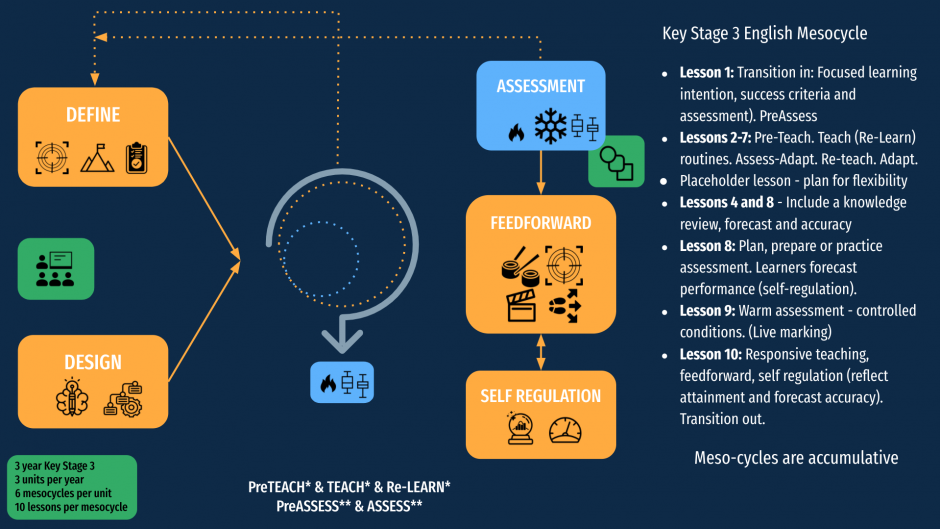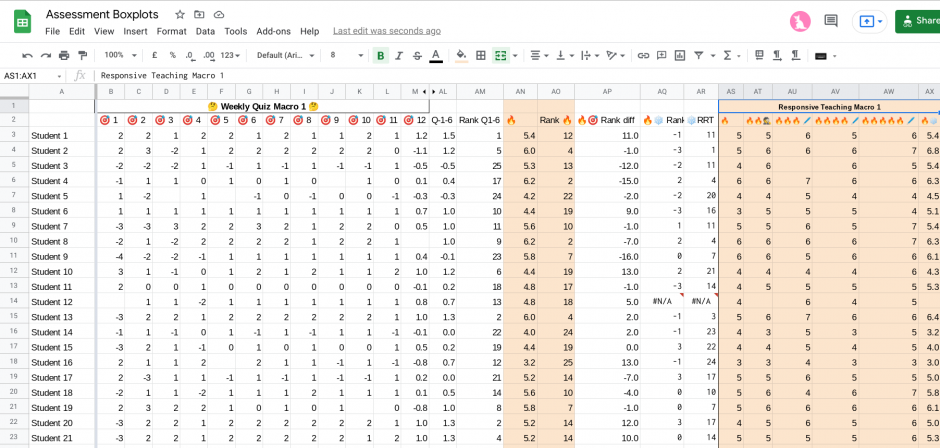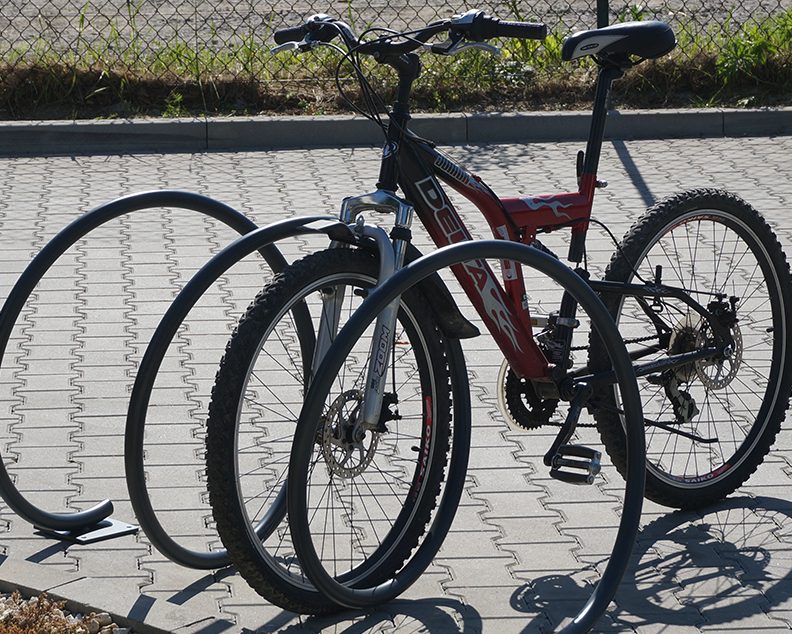Designing a the Meso-cycle
As explained in part 1, the key determinant of a meso-cycle is that it is designed to accomplish a particular goal, here a cycle of ‘responsive teaching.’ Harry Fletcher-Wood offers a working definition that draws on cognitive science, his own teaching experience, formative assessment and a ‘central organising principle’ of relationships.
- Setting clear goals and planning learning carefully
- Identifying what students have understood and where they are struggling
- Responding, adapting our teaching to support students to do better.
It is important to note that step 1: ‘Setting clear goals’ is itself a responsive step, to be informed by what the pupils already know. The quickest route to knowing what the pupils already know – a pre-test. A pre-test that will undoubtedly inform the “Setting clear goals.”
Second, meso-cycles are defined, in part, by school and curriculum factors, eg timetabling and lesson allocation inequalities / half term cycles. Defining a cycle in terms of lessons, means a meso-cycle can be applied across these inequalities.
For core subjects, 10 lessons is typically 2 weeks, 6 meso-cycles half term. Teaching/learning/encoding and remembering/relearning (successive relearning) upon short or condensed intervals.
For foundation subjects, 10 lessons may represent 4 or 6 weeks, just 3 or 2 per half term. Therefore spaces between lessons are wider and successive relearning within a cycle may arguably be even more potent?
Part 2 shared the building blocks:
Responsive Teaching – “relatively short teaching cycles with responsive teaching tasks (assessments) and whole class feedback lessons.” A bias towards the importance of cumulative assessment. Ausubel (1968) reference – know the learn, know what the learner already knows. The uncomfortable truth is that pupils do not learn what it is we teach them and the distinction of performance versus learning. Routines and successive relearning. Classrooms as complex adaptive systems a model that can articulate and flex. Micro, meso and macro cycles.
Meso-cycle
As far as I am aware, there are no guidelines or research pertaining to teaching-instruction planning as meso-cycles. It is a hybrid term that I borrowed from Sport Science, adding to the more familiar terms of micro and macro cycles. Perhaps most importantly, a meso-cycles married neatly with Responsive Teaching and Successive Relearning. So take this post with a pinch of educational salt. If you do adapt it for your teaching-instruction, or if you have a constructive point to raise, I would be interested to hear it.
What might a meso-cycle build or recipe look it? This is the model I adopted. 10 x 50 minutes lessons a fortnight. 6 a term, 6 a scheme of learning.
Lesson 1: Transition in: Focused learning intention, success criteria and assessment. PreAssess the learners prior knowledge.
Lessons 2-7: Pre-Teach. Teach-Assess-Adapt. Re-teach. Adapt. – what you and I would call “teaching.” Assign a place-holder lesson for reteaching or revisiting taught but insecure knowledge. Practice opportunities, micro-assessments, often have the same surface details as the final assessment.
Lessons 4 and 8 – Include a knowledge review, forecast and accuracy (promotes self-regulation)
Lesson 8: Plan, prepare or practice assessment. Learners forecast performance (self-regulation).
Importantly – a double page spread is used. Planning on the left, response on the right. To minimise negative transitory effects.
Lesson 9: Warm assessment – controlled conditions. (Applied practice, for learning, in class, live marking (again for learning) is an option) In lessons of 55-60 we are clear that writing time is 80% (40 mins) and editing is 20%. (10 mins). Verbalising the text is encouraged. 5 mins reflect / admin, collect papers.
Lesson 10: Responsive Teaching, feedforward, self regulation (reflect attainment and forecast accuracy). Transition out.

Importantly, meso-cycles are accumulative, each meso-cycle connecting with and building upon the previous meso-cycles, with assessment always drawing upon, assessing / sampling all the knowledge to date (see table below).
Certainly within the scheme, or macro cycle at the very least (this draws on the potential for and principles of interleaving). Potential across the academic macro cycle, or even Key Stage. The final meso-cycle closes the unit, with a summative or cold, or unseen, controlled / exam style high control assessment. I would, where ever possible, signpost the next meso-cycle and any pre-teaching available. Transition out. Potentiating the transition in.
Feedback from colleagues centred on the absence of ‘checking for understanding.’ Within the meso and micro-cycles is a blue dotted circle, encircling ‘assess,’ with the triadic relationship of teach-assess-adapt. Gathering ‘evidence’ of students learning is at the heart of the model – is ongoing and continuous.
Why Accumulative Assessment
Now, regrettably, our students do not learn what we teach. It is, as Dylan Wiliam references, a “brute fact.” Even once our students have learnt what it is we want them to know, it is not to say that they will not forget it or have difficulty accessing and retrieving it when required. Don’t forget, I had been shocked, quite literally bemused, but how little students retain between lessons on the same day. Let alone, lessons across the week, where in the meantime, more facts and knowledge were being poured in on top. Therefore, again, I recommend that meso-cycles are accumulative, Successive Learning be central tenet of your teaching-instruction and that assessment be also. Accumulative within a year, and even, across years. Second, have a common framework for assessment (value-point allocation) as a way to standardise ‘performance’ (a moment in time) and also measure the assessment difficulty. Across a macro cycle it may look something like:
| Assess 1 | Assess 2 | Assess 3 | Assess 4 | Assess 5 | Assess 6 | |
| Meso 1 | 100% | 30% | 20% | 10% | 10% | 10% |
| Meso 2 | 70% | 20% | 20% | 10% | 10% | |
| Meso 3 | 60% | 20% | 10% | 10% | ||
| Meso 4 | 50% | 20% | 10% | |||
| Meso 5 | 50% | 10% | ||||
| Meso 6 | 50% | |||||
| Total | 10 | 3+7 | 2+2+6 | 1+2+2+5 | 1+1+1+2+5 | 1+1+1+1+1+5 |
You may choose to only apply this accumulative model to the end of term assessments.
Now, regrettably, our students do not learn what we teach. It is, as Dylan Wiliam references, a “brute fact.” Even once our students have learnt what it is we want them to know, it is not to say that they will not forget it or have difficulty accessing and retrieving it when required. Don’t forget, I had been shocked, quite literally bemused, but how little students retained between lessons taught on the same day. Let alone, lessons across the week, where in the meantime, more facts and knowledge were being poured in on top. Therefore, again, I recommend that meso-cycles are accumulative, Successive Learning be central tenet of your teaching-instruction and that assessment be also. Accumulative within a year, and even, across years. Second, have a common framework for assessment (value-point allocation) as a way to standardise ‘performance’ (a moment in time) and also measure the assessment difficulty. Across a macro cycle it may look something like:
| Assess 1 | Assess 2 | Assess 3 | Assess 4 | Assess 5 | Assess 6 | |
| Meso 1 | 100% | 30% | 20% | 10% | 10% | 10% |
| Meso 2 | 70% | 20% | 20% | 10% | 10% | |
| Meso 3 | 60% | 20% | 10% | 10% | ||
| Meso 4 | 50% | 20% | 10% | |||
| Meso 5 | 50% | 10% | ||||
| Meso 6 | 50% | |||||
| Total | 10 | 3+7 | 2+2+6 | 1+2+2+5 | 1+1+1+2+5 | 1+1+1+1+1+5 |
The best way to change long-term behaviour is with short-term feedback.
You may choose to only apply this accumulative model to the end of term assessments only.
Now, regrettably, our students do not learn what we teach. It is, as Dylan Wiliam references, a “brute fact.” Even once our students have learnt what it is we want them to know, it is not to say that they will not forget it or have difficulty accessing and retrieving it when required. Don’t forget, I had been shocked, quite literally bemused, but how little students retain between lessons on the same day. Let alone, lessons across the week, where in the meantime, more facts and knowledge were being poured in on top. Therefore, again, I recommend that meso-cycles are accumulative, Successive Learning be central tenet of your teaching-instruction and that assessment be also. Accumulative within a year, and even, across years. Second, have a common framework for assessment (value-point allocation) as a way to standardise ‘performance’ (a moment in time) and also measure the assessment difficulty. Across a macro cycle it may look something like:
| Assess 1 | Assess 2 | Assess 3 | Assess 4 | Assess 5 | Assess 6 | |
| Meso 1 | 100% | 30% | 20% | 10% | 10% | 10% |
| Meso 2 | 70% | 20% | 20% | 10% | 10% | |
| Meso 3 | 60% | 20% | 10% | 10% | ||
| Meso 4 | 50% | 20% | 10% | |||
| Meso 5 | 50% | 10% | ||||
| Meso 6 | 50% | |||||
| Total | 10 | 3+7 | 2+2+6 | 1+2+2+5 | 1+1+1+2+5 | 1+1+1+1+1+5 |
You may choose to only apply this accumulative model to the end of term assessments only.
| Assess | |
| Meso 1-6 | 100% |
| Meso 7-12 | 30% (1-6) + 70% (7-12) |
| Meso 13-18 (end of year) | 20% (1-6) + 20% (7-12) + 60% (13-18) |
You may chose for the annual Macro assessments to be accumulative:
| Year 7 | Year 7 |
| Year 8 | 30% Year 7 + 70% Year 8 |
| Year 9 | 20% Year 7 + 20% Year 8 and 60% Year 8 |
The meso-cycle assessment performance is then box plotted (performance and variance) and tracked. Crucially, that teachers adapt their teaching to respond to what assessment tells them. It is what the Great Teaching Toolkit refers to as ‘interacting.’
The quality of learning interactions between teachers and students is central to the learning process. Interactions may be seen as a form of feedback, and again there are two distinct purposes here: feedback to teachers that informs their decisions, and feedback to students that helps them learn.
Great Teaching Toolkit
Over the macro cycle or academic year. Using a common framework for assessment framework, performance can be aggregated, and is there more powerful and less prone to single assessment error. Assessment that can be aggregated by learner or class or cohort.
As yet, I have not applied this model beyond a single curriculum area.
And so the model was updated and extended.
Warm and Cold Assessment
Warm assessments are designed for learning, designed and supported for success and for building confidence. An important point to note here is that student practice generally needs to be monitored and guided initially (Rosenshine, 2010).
Warm assessment, particular those with live, in-the-moment corrective feedback, or scaffolds, or directions, maybe considered less valid. Hence an aggregated score will be more reliable. You may wish to correlate warm and cold assessment ranks as shown in this assessment tracker. Here the warm assessment are a weekly 10 question quiz, aggregates, against the Responsive Teaching tasks.

When the Warm assessment were aggregated it was clear that further investigate on Mesocycle 4 would prove worthwhile. Ranks on the aggregated Warm assessments and Cold assessment were very similar.

Cold assessments are designed to verify attainment. Given the higher control, you may choose to aggregate only cold assessments.
So, is the model finished now? No. Not yet. One more important step back to take, the macro view. Then to close with why I believe that Successive Relearning is important.
Oct 22, 2022 Update
When building this model, I did not make room for self-assessment. I should have. There is a wealth of research demonstrating the value of self-assessment:
…students who engaged in self-grading performed better on subsequent tests than did students who did not.
Sanchez et al., 2017.
Add to that, more recent reading, that self-assessment offers logistical time savings gains (Bould, 1989) and expedited feedback (McLeod, 2001). Next, there are pedagogical gains for deepening understanding (Boud, 1989). Metacognitive gains – identifying strengths and gaps in knowledge progress, and gaps (Black & Atkin, 1996). Lastly, affective gains, more productive, friendlier, and cooperative, classrooms where pupils can build a greater sense of shared ownership (Baird & Northfield, 1992; McLeod, 2001; Pfeifer, 1981; Weaver & Cotrell, 1986; Zoller, Ben-Chaim, & Kamm, 1997).
Self-assessment marries particular well with warm assessments.
Onwards. Still looking for evidence on the validity or accuracy or confidence of students self-assessment.





Pingback: Do teachers know thy impact – Edventures
Pingback: Why Quiz? Effective quizzing routines (Part 2) – Edventures
Pingback: Bahrick to classroom – two phases or three? (part 1) – Edventures
Pingback: Bahrick to classroom – two phases or three? (part I) – Edventures